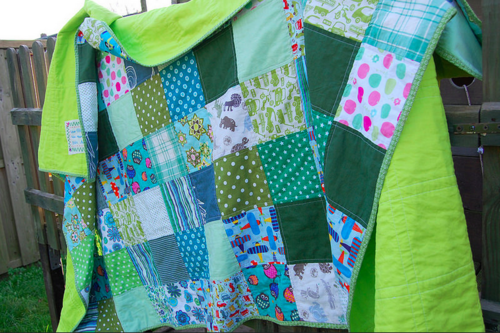
Patchwork and quilting use the same techniques and are often considered together when explaining techniques and approaches. Both crafts are very resourceful and make use of any fabrics available, from flour and feed sacks to old clothing, from leftover fabrics to the finest materials. Patchwork and quilting can be done by hand or machine, of a combination of both. Given time constraints, many people prefer to machine stitch now but it is still perfectly fine to stitch a quilt or patchwork by hand, working slowly over time as a special project. Indeed, many people find such a craft relaxing and calming.
Patchwork refers to the sewing craft of constructing a cover, hanging or item of clothing from pieces of fabric of varying shapes, sizes and colours. The pieces are usually sewn together in geometric shapes to create an interesting or bold pattern but patchwork can also be random elements stitched together from scrap fabrics.
Quilting is also able to produce a cover, hanging or item of clothing but uses the process of placing two sheets of fabric together with padding in between, then using stitching to hold the fabric sheets together and often to create part of the design. Patchwork is often used on the top layer of the quilt to form the design, and as such, is fairly much inseparable from patchwork unless only stitching is used to form the design.
While today, modern types of batting/filling/wadding are used inside of a quilt, in olden times quilts would often be stuffed with such natural materials as straw, dried grass or herbs, feathers, scrap fabric layers or yarn. The type of stuffing would depend on the end use for the quilting, from padded clothing through to warm bedding.
Fabrics for patchwork and quilting[edit | edit source]
As already noted, many types of fabric sources can be used to create patchwork or quilts. The most important rule is that whatever fabric is chosen should be of a similar weight so that there isn't undue strain placed on any area of the finished product.
Most fabrics require a wash before using, even brand new ones from the store may benefit from this. Some fabrics need washing to ensure that they are the final size before sewing; it's not much fun washing the quilt only to have some pieces shrink and no longer fit properly.
Typical fabrics include cotton in various weights, blanket wool pieces and some synthetic fabrics. In some cases, interesting sources of fabrics can be used such as old clothing, cotton flour bags (especially the portion with the label), antique fabrics, old satin sheets/pillow cases, etc. If repurposing fabrics, always wash well, check for colour fastness and be sure they are going to be durable enough for both the stitching and the end use.